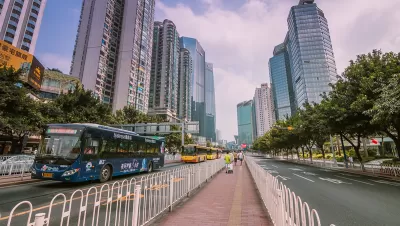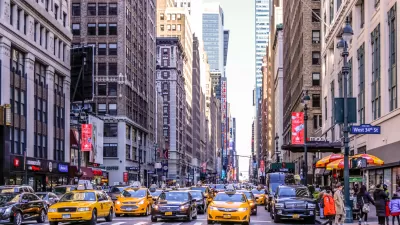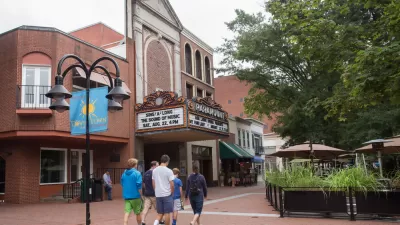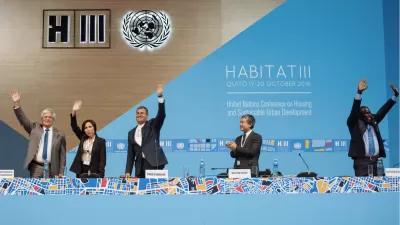Despite depressing U.S. federal politics, there are many encouraging planning trends if you look internationally and locally.

There was plenty of depressing news for U.S. planners last week. The Trump Administration budget proposal would cut funding for public transit, urban development and affordable housing, and basic data collection, which would reduce our ability to increase transport system efficiency, reduce social inequity, and protect our environment. Sad!
However, if you look beyond the headlines, you can find encouraging planning trends.
I spent last week in the Laoshan capital of Vientiane, as a keynote speaker [pdf] at the Tenth Environmentally Sustainable Transportation (EST) Forum in Asia, which provides leadership in creating more sustainable transportation and land use planning in the world’s most populous and fastest growing region. There was lots of good news [pdf] there. The EST Forums were originally established to reduce local air pollution problems, but over time expanded to include additional planning goals related to traffic safety, economic development, social equity, affordability, and resilience, to name a few. Participants soon realized that everything is connected, so they tend to support integrated solutions [pdf] that provide multiple benefits, such as the emission reduction strategies that also reduce parking problems, traffic congestion, and collisions.
While U.S. planning faces obstacles and uncertainty, international programs support more integrated and effective planning. They tend to apply the Avoid, Shift, and Improve [pdf] concept, which recognizes that transportation demand management strategies that reduce total motor vehicle travel can provide much greater total benefits [pdf] than strategies which only improve vehicle operation, for example, by encouraging alternative fuel vehicles. As a result, major international development organizations such as the Asian Development Bank [pdf], the World Bank and the United Nations Center for Regional Development are investing less in urban highway projects and much more in Bus Rapid Transit, pedestrian and cycling improvements, parking policy reforms [pdf], and better urban planning. International organizations such as the New Climate Economy, the Institute for Transportation and Development Policy (ITDP), and the Ross Center for Sustainable Cities have produced terrific resources to support more integrated planning. These programs are not dramatic or glamorous, but they result in better planning practices that provide a solid foundation for creating more efficient and equitable communities.
Here are some good examples of integrated planning:
 During the last decade, more than two dozen Chinese cities have developed Bus Rapid Transit networks, which offer high quality service to attract discretionary travellers who could drive. In 2011, Guangzhou won the Sustainable Transport Award for its outstanding BRT network, which carries approximately a million daily passengers and offers amenities such as its bikesharing program. Last year, Yichang, a mid-sized Chinese city located along the Yangtze River, won the same award for its focus on pedestrian and cycling improvements, and high-quality mass transport.
During the last decade, more than two dozen Chinese cities have developed Bus Rapid Transit networks, which offer high quality service to attract discretionary travellers who could drive. In 2011, Guangzhou won the Sustainable Transport Award for its outstanding BRT network, which carries approximately a million daily passengers and offers amenities such as its bikesharing program. Last year, Yichang, a mid-sized Chinese city located along the Yangtze River, won the same award for its focus on pedestrian and cycling improvements, and high-quality mass transport.
Mobility for All; A Strategic Transportation Plan for Ranchi [pdf], is a comprehensive plan for increasing transport system efficiency and equity in the Indian city of Ranchi by improving resource-efficient modes (walking, cycling, and public transport) and applying Complete Streets and Smart Growth development policies. This plan was developed through a partnership between the Institute for Transportation and Development Policy (ITDP), an international organization, the Ranchi Mobility Partnership, and various other local groups. The report evaluates existing travel conditions by both low- and higher-income travellers based on a series of user surveys. Based on this analysis, the report recommends specific system improvements, including enhanced walking and cycling facilities, public transport improvements including 225 kilometers of bus service with 32 kms of bus rapid transit corridors, and new measures for controlling and managing the use of personal motor vehicles.
 The city of Vientiane closes off major streets to motor vehicle traffic most evenings to create Walking Streets and open-air Night Markets, filled with pedestrians, cyclists, and dancers. Joining these crowds was the high point of my recent visit!
The city of Vientiane closes off major streets to motor vehicle traffic most evenings to create Walking Streets and open-air Night Markets, filled with pedestrians, cyclists, and dancers. Joining these crowds was the high point of my recent visit!
These and countless other projects reflect the results of new, more responsive, integrated and multi-modal planning. Of course, tremendous changes are needed to make rapidly-developing cities efficient, equitable, and liveable, which means lots of challenging but rewarding work for planners.
I am also encouraged by efforts by local and regional governments in the United States to develop more multi-modal transportation systems and support Smart Growth policies. For example, Atlanta, Georgia, Nashville, Tennessee, and rural Texas have major commitments to improve public transportation and create more walkable neighborhoods, because community members realize that more multi-modal transportation systems provide multiple benefits. Regardless of whether or not there is federal leadership, most communities will continue with such programs because residents demand them.
These planing programs recognzie that to be efficient and equitable, urban transportation systems must give priority to space-efficient modes, such as walking, cycling and transit buses, over space-intensive modes such as automobiles, which justify dedicated bike and bus lanes, reduced parking supply, and more compact, mixed development patterns. They reflect comprehensive analysis which considers diverse objectives and solutions. These concepts are not liberal or conservative, Democrat or Republican; they simply reflect good planning and resource management.
These are challenging times, but please don’t give up hope! Our techniques and tools are more important than ever for identifying real solutions to the problems communities face.

Planetizen Federal Action Tracker
A weekly monitor of how Trump’s orders and actions are impacting planners and planning in America.

Maui's Vacation Rental Debate Turns Ugly
Verbal attacks, misinformation campaigns and fistfights plague a high-stakes debate to convert thousands of vacation rentals into long-term housing.

San Francisco Suspends Traffic Calming Amidst Record Deaths
Citing “a challenging fiscal landscape,” the city will cease the program on the heels of 42 traffic deaths, including 24 pedestrians.

Defunct Pittsburgh Power Plant to Become Residential Tower
A decommissioned steam heat plant will be redeveloped into almost 100 affordable housing units.

Trump Prompts Restructuring of Transportation Research Board in “Unprecedented Overreach”
The TRB has eliminated more than half of its committees including those focused on climate, equity, and cities.

Amtrak Rolls Out New Orleans to Alabama “Mardi Gras” Train
The new service will operate morning and evening departures between Mobile and New Orleans.
Urban Design for Planners 1: Software Tools
This six-course series explores essential urban design concepts using open source software and equips planners with the tools they need to participate fully in the urban design process.
Planning for Universal Design
Learn the tools for implementing Universal Design in planning regulations.
Heyer Gruel & Associates PA
JM Goldson LLC
Custer County Colorado
City of Camden Redevelopment Agency
City of Astoria
Transportation Research & Education Center (TREC) at Portland State University
Jefferson Parish Government
Camden Redevelopment Agency
City of Claremont






























